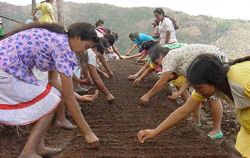Key Terms in Gender Analysis
 |
| Gender differences, which heavily influence differences in economic and social roles and access, should not be assumed but investigated, since they vary from one context to another as well as one time period to another. Photo Source: DevTech Systems, Inc.
|
A range of similar-sounding terms circulates throughout discussions of gender in development. A number of these, but by no means all, are briefly described below:
Sex and Gender
The statement that gender is not synonymous with sex is now widely accepted if not wholly understood.
- Sex refers to the biological characteristics that define males and females according to physical characteristics and reproductive capabilities;
- Gender refers to the economic, social, political, and cultural attributes and opportunities associated with being a man and a woman. The nature of gender definitions and patterns of inequality vary among cultures and change over time.
Sex is therefore universal and unchanging while gender is a socially defined category that changes. This distinction is important; it means that gender differences should not be assumed but investigated, since they vary from one context to another as well as one time period to another.
Gender Analysis and Gender Assessment
Gender Analysis refers to the socio-economic methodologies that identify and interpret the consequences of gender differences and relations for achieving development objectives as well as the implications of development interventions for changing relations of power between women and men.
Gender Assessments involve carrying out a gender analysis of organizations' programs and of their ability to monitor and respond to gender issues throughout the program cycle.
Gender-Based Constraints
Gender-based constraints are factors that inhibit either men's or women's access to resources or opportunities of any type. They can be formal laws, attitudes, perceptions, values, or practices (cultural, institutional, political, or economic).
For example:
- Customary laws dictating that only men can own land is a gender-based constraint on agricultural production since it can prevent women from producing or marketing crops or obtaining credit.
- A law that prevents pregnant teenagers from attending school is a gender-based constraint since it disadvantages girls relative to boys in obtaining an education.
- An HIV/AIDS program that is located in an ante-natal clinic could constitute a gender-based constraint if men are reluctant to get tested in this setting.
Gender Equality
Gender Equality refers to the ability of men and women to have equal opportunities and life chances.
A World Bank policy report on gender (Engendering Development, 2001) identifies three dimensions of gender equality as "equality under the law, equality of opportunity..., and equality of voice (the ability to influence and contribute to the development process)".
As stated in the 1998 Development Assistance Committee (OECD/DAC) guidelines on gender:
[T]he emphasis on gender equality...does not presume a particular model of gender equality for all societies and cultures, but reflects a concern that women and men have equal opportunities to make choices about what gender equality means and work in partnership to achieve it.
Gender equality is a U.S. Government-endorsed goal of development and development cooperation efforts. Gender equality is also Goal 3 of the Millennium Development Goals: "Promote gender equality and empower women."
Gender Equity
Gender Equity refers to a fair distribution of resources and benefits between men and women according to cultural norms and values.
Equity is therefore harder to measure in objective terms, and, because it is based on locally-specific definitions, it varies between and within countries.
It can be used, for instance, to describe situations wherein women are still significantly disadvantaged relative to men.
For example, a situation in which women inherit less than men do, but in a way that is not exclusionary per se and is otherwise 'fair' in local terms, could still be described as equitable in terms of gender.
USAID's Glossary of Gender Terms and Concepts refers to equity strategies as those processes used to achieve gender equality. Equity involves fairness in representation, participation, and benefits afforded to males and females. The goal is that both groups have a fair chance of having their needs met and each has equal access to opportunities for realizing their full potential as human beings.
Gender Integration and Gender Mainstreaming
Two other terms, gender integration and gender mainstreaming, refer to the process for working toward the goal of gender equality in development programs.
Gender Integration involves identifying and then addressing gender differences and inequalities during program and project design, implementation, monitoring, and
evaluation. Since the roles and relations of power between men and women affect how an activity is carried out, attending to these issues on an ongoing basis is essential.
Gender Mainstreaming is the process of assessing the implications for women and men of any planned action, including legislation, policies, or programs in any area
and at all levels. It refers to strategies for making women's as well as men's concerns and experiences an integral dimension in the design, implementation, monitoring,
and evaluation of policies and programs in all political, economic, and social spheres such that inequality between men and women is not perpetuated.
Gender mainstreaming is a globally accepted strategy for promoting gender equality. Mainstreaming is not an end in itself but a strategy, an approach, a means to achieve
the goal of gender equality. Mainstreaming involves ensuring that gender perspectives and attention to the goal of gender equality are central to all activities - policy
development, research, advocacy/ dialogue, legislation, resource allocation, and planning, implementation and monitoring of programmes and projects.
2
2. United Nations: Special Adviser to the Secretary-General on Gender Issues and the Advancement of Women (OSAGI) Website: Terms and
Concepts. UN, OSAGI, http://www.un.org/womenwatch/osagi/gendermainstreaming.htm
The term, adopted by the 1995 Fourth World Conference on Women in Beijing, addresses the institutional arrangements that are needed to achieve gender equality.
Gender mainstreaming is more inclusive than gender integration, as it goes beyond looking at gender in specific programs and incorporates gender dimensions
explicitly into all levels of development effort, including policy formulation, planning, evaluation, budgeting, and decision-making.
Sex-disaggregated data
USAID policy calls for the collection and analysis of sex-disaggregated data for individual-level indicators and targets. Disaggregating data by sex enables valid
cross-country comparisons. Gender analysis of the sex-disaggregated data should be carried out in order to determine what impact development activities have on gender relations.
Back to Top ^
|




